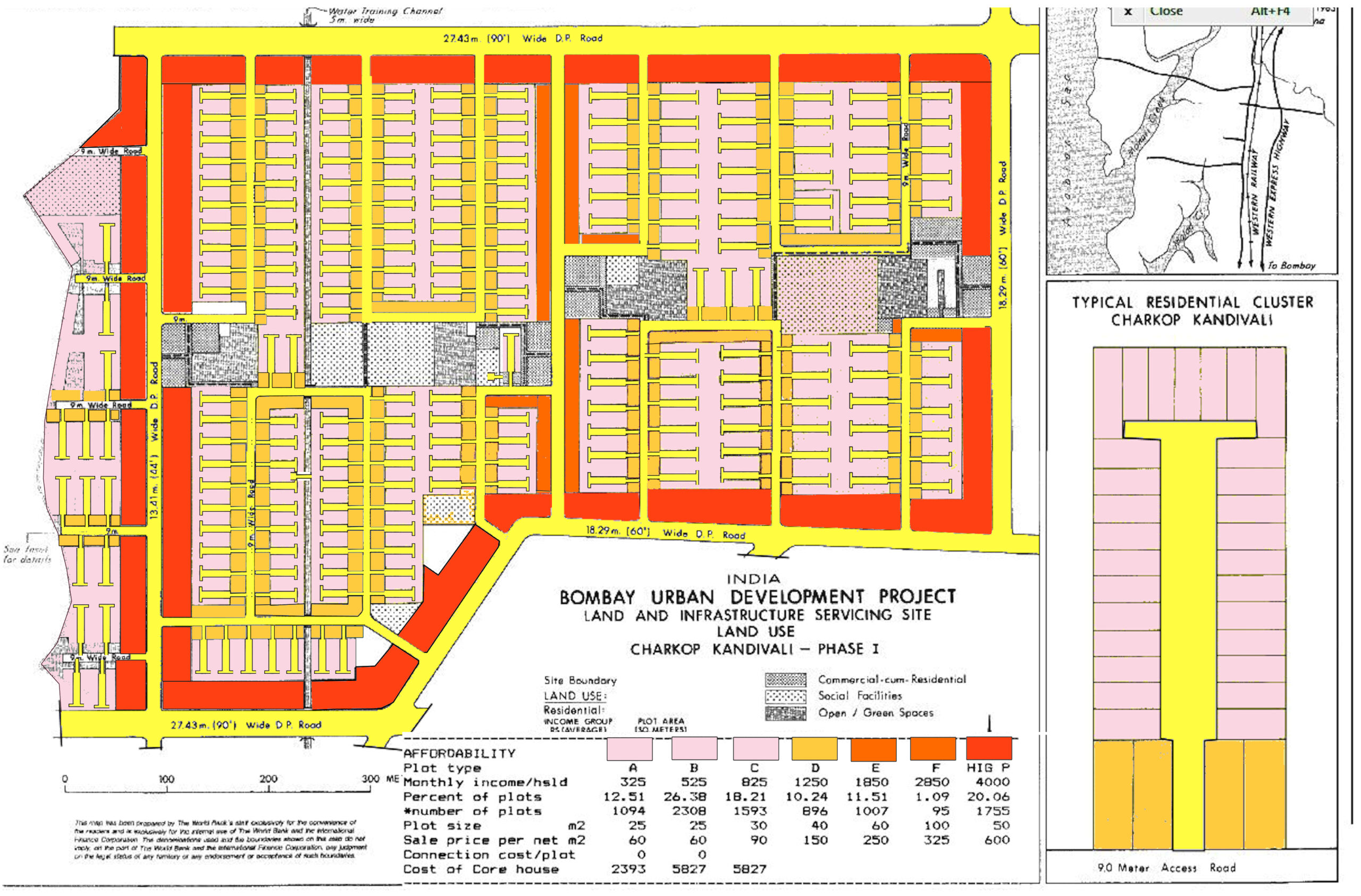Physical Address
304 North Cardinal St.
Dorchester Center, MA 02124
Physical Address
304 North Cardinal St.
Dorchester Center, MA 02124

Check out Alain Bertaud's Master Class lecture at CEPT University in Ahmedabad, India.
A new paper in the Journal of Development Economics by Liming Chen, Rana Hasan, Yi Jiang, and Andrii Parkhomenko estimates the welfare gains of Transit Oriented Development in Bengaluru. The Bengaluru metro or the Namma metro is around 170Km long including the planned sections. Bengaluru has low building heights and the paper’s counterfactual depends on relaxing FSI/FAR from their current level to 2 (only 2!) around 500 meters of the metro line. The paper finds “The complementarity between TOD and the metro unlocks additional gains equivalent to about $64 million per year or one-half of annual operating costs of the metro system.” Paper reference:Chen, L., Hasan, R., Jiang, Y., & Parkhomenko, A. (2024). Faster, taller, better: Transit improvements and land use policies. Journal of Development Economics, 103322.

Alain Bertaud revisits a Mumbai development project he helped design in 1983. The neighborhood is thriving.

A 2017 increase in allowed floor area ratio in Mumbai had a tremendous impact on affordability by accidentally improving the economics of smaller apartments.

Zoning regulations inflict great harm. But it is difficult for Americans to imagine the cost of zoning in Indian cities. Delhi is one of the most crowded cities in the world, and there is great demand for floor space. But real estate developers are not allowed to build tall buildings.
1. This week at Market Urbanism: Emily Washington described The Need For Low-Quality Housing in America’s most desirable cities. People of very little means could afford to live in cities with the highest housing demand because they lived in boarding houses, residential hotels, and low-quality apartments, most of which are illegal today. Making housing affordable again requires not only permitting construction of more new units, but also allowing existing housing to be used in ways that are illegal under today’s codes. Adam Hengels posted part 7 in his long dormant Rothbard the Urbanist series Tragically, Rothbard’s insights on these subjects have been mostly neglected for over 30 years, while apologists for sprawl and automobile dominance have nearly monopolized the conversation among free-market advocates. 2. At the Market Urbanism Facebook Group: Naor Deleanu updated us on San Diego‘s stadium subsidy proposal Mark Frazier shares the pros and cons of a privately-run city in India Nolan Gray: Classic New York Streetscapes, Then and Now Interesting what changed and what hasn’t Anthony Ling shared an invite to a conference at NYU. Success Without Design: Lessons from the Unplanned World of Development 3. Elsewhere: Highways gutted American cities. So why did they build them? Stephen Eide makes the case for states taking back control from mismanaged cities. An interview with the author of “Evicted:” a story of “eight peripatetic families in Milwaukee — and two landlords” How Chicago racked up a $662M police misconduct bill …not to be outdone, Chicago’s teachers’ union may strike again 4. Stephen Smith‘s Tweet of the Week: “Housing is a human right,” says the group founded for the sole purpose of preventing new housing from being built https://t.co/mvpBmDda1R — Market Urbanism (@MarketUrbanism) March 19, 2016
1. This week at Market Urbanism: Shanu Athiparambath has his first post on the blog via Scott Beyer: Economist David Friedman Says India Must Go Taller to Make Homes Affordable I remember my father saying that when he visited India in the 1950s and 1960s, bureaucrats in Delhi made arguments for restricting luxuries for the rich in air-conditioned luxury hotels where bureaucrats and American visitors held conferences. Emily Washington: Reforming Zoning in a Kludgeocracy While studying economics often leads people to think about the ceteris paribus effect of a policy change, in the real world, a policy will rarely be changed without resulting in domino effect of other changes in other policies and market outcomes because land-use policy is entangled with so many other policies. 2. Where’s Scott?: Scott Beyer is spending a final weekend in New Orleans before heading to Oklahoma City. This week, he wrote for National Review about rapid high-rise growth in the Miami neighborhood of Brickell. Starting as a low-slung neighborhood, it grew to become what it now is thanks to the city’s tolerance of unfettered growth. And rather than bringing Armageddon, as critics of rapid urban development might suspect, Brickell has become an economic powerhouse and an urban destination. At a time when so many other cities suppress development — and suffer the consequences – Brickell symbolizes a mentality worth restoring throughout urban America. 3. At the Market Urbanism Facebook Group: Nick Zaiac wants you to check out Cato’s new study related to immigration and housing affordability Tobias Cassandra Holbrook is interested in London’s growing skyline: Don’t listen to the Nimbies – skyscrapers can make London great again R John Anderson introduced the group to his latest post explaining where small urban developers should be looking to build 4. Elsewhere: New study confirms that boomers are clueless about where they like to live. h/t: Charles […]
Recently I’ve been seeing a lot of articles about slums (the NYT on Gurgaon, India, and the Guardian on Cairo), and inevitably the phrase “free market” gets thrown around. And as it should – so-called “slums” often have very minimal active governance, and as a result they often have very dynamic economies and upwardly mobile citizens (something even the New York Times and Guardian, two very liberal papers, recognize). But it’s lazy to equate them with the free market, and unfortunately I see a lot of people doing that. One problem with slums, from a free market point of view, is that only certain investments are secure. People and their houses (well, at least the owner-occupied ones) are the safest, especially in democracies like Brazil and India. Though of course there are stories of people’s homes in slums being demolished or taken by the government without compensation, it’s my understanding that this is becoming rarer as slum dwellers grow in number and political power. Residents are likely to get titles in some Hernando de Soto-inspired regularization scheme, so people invest in their homes. Residential areas harden as sheet metal turns into bricks, houses get proper roofs, and we start to see two- and three-story structures. Infrastructure, however, is another story. While many newspapers I think generally exaggerate the lack of services (I refuse to believe the Times’ assertion, for example, that Gurgaon only has employer-funded mass transit – there must certainly be share taxi/small bus services, or at least motortaxis), there does appear to be a real lack. The poorer areas often have open sewers, and running water in homes is rare. Many critics take this as evidence that infrastructure – paved roads, mass transit, electricity, waste collection, water – will not be adequately provided for in a free market, which […]
Prince Charles, perhaps the world’s most famous urbanist, on Dharavi, which he’s planning to replicate in either Calcutta or Bangalore: Unlike the ‘fragmented, deconstructed housing estates’ built in the West, the slum has ‘order and harmony’ he claimed, adding: ‘We have a great deal to learn about how complex systems can self-organise to create a harmonious whole.’ Though he’s got good things to say about organic development, his critiques of modern architectural styles and his habit of injecting himself into planning decisions have not earned him fans in the UK, where two years ago a group of architects actually sent him a letter telling him to shut up: Charles’s “private comments and behind-the-scenes lobbying” were anomalous in a modern, democratic system, said the letter writers, who also included Jacques Herzog and Pierre de Meuron, the Swiss duo whose practice turned the former Bankside power station into the Tate Modern, and Italy’s Renzo Piano, the co-designer with Rogers of the Pompidou Centre in Paris. […] Rogers’ proposals for the Chelsea site had already been adapted following local objections and were now in the hands of Westminster council planners, they noted. “If the prince wants to comment on the design of this, or any other, project, we urge him to do so through the established planning consultation process. Rather than use his privileged position to intervene in one of the most significant residential projects likely to be built in London in the next five years, he should engage in an open and transparent debate.” “This is not really about a style, or an argument about how buildings look, but how we go about things,” said Deyan Sudjic, the director of the Design Museum in London, who also signed the letter. “What’s slightly depressing is that this is kind of an old argument […]
1. Mumbai is rethinking its density bonuses for developers who build parking lots and hand them over free of charge to the city. 2. Tort liability driving away possible MARC operators. 3. San Mateo County legislators threaten to charge San Franciscans a congestion charge similar to the one that the city is proposing to charge San Mateo (and East and North Bay) commuters. Bring it on, I say – it’s about time drivers were charged for using local roads. 4. The Supreme Court refuses to hear West Harlem business owners’ appeal against the city’s decision to use eminent domain to hand Manhattanville over to Columbia University. 5. The NYT has a story about a commercial kitchen-for-rent in Queens, calling it a “lifeline” for for “100 small businesses.” It’s a nonprofit, but even renting a space there for 6.5 hours in the middle of the night costs $154. I’m still waiting for the Times story about the many more people who cook illegally out of their own homes and whose businesses are therefore stunted and precarious, all because they can’t afford to comply with the city’s onerous health and zoning codes. 6. The US may have 1 billion parking spaces. This does not in and of itself prove that we have too much, but for those of us who already believe that zoning codes mandate more parking than the market would provide (for which there is good empirical evidence), it’s a horrifying thought. 7. Yonah Freemark discusses how Hong Kong’s transit agency uses property development to internalize positive transit externalities and maintain (relative) independence from the municipality. 8. The WSJ reports on the strong market for downtown office space, especially compared to declining suburban office parks.